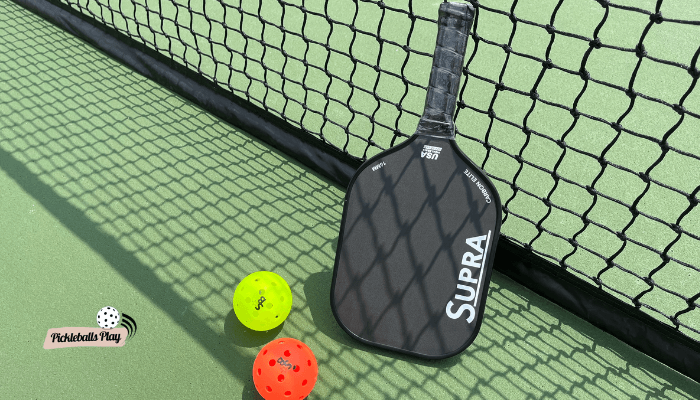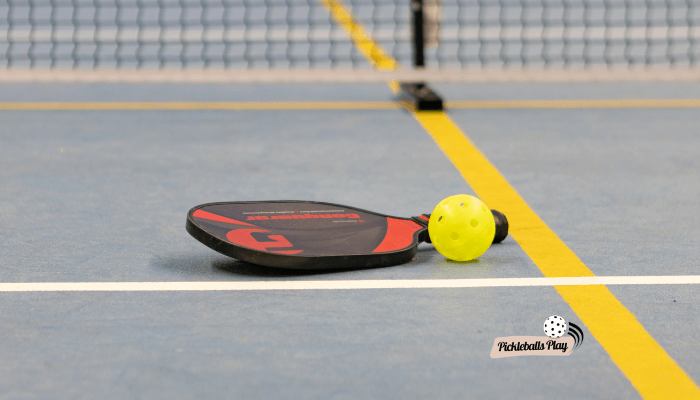Are you looking to take your pickleball game to the next level? Improving your reaction time is vital! Quick reflexes can differentiate between a winning shot and a missed opportunity. Whether you’re a beginner or an experienced player, there are strategies you can use to improve your reaction time on the court. In this blog post, we will cover some tips on how to improve reaction time for pickleball.
We’ll explore why reaction time is essential in pickleball and provide tips for how you can boost it. So let’s get started!

Why is Pickleball Reaction Time Important?
Pickleball reaction time is a crucial skill for any player, as it determines how quickly you can respond to an opponent’s shot. Reaction time can be the difference between winning and losing a point, which is imperative in competitive pickleball matches. As such, players must practice their reaction speed to stay competitive and improve their game. You can quickly recognize patterns and anticipate shots better by training your reflexes.
Furthermore, developing your reaction time helps increase hand-eye coordination so that you can return shots with precision and accuracy. It also allows players to remain composed under pressure during intense rallies or when playing against skilled opponents. In short, pickleball reaction time is essential for improving overall performance on the court; therefore, all serious players should strive to increase their reflexes as much as possible.
7 Tips & Strategies to Improve Your Reaction Time
Pickleball players can improve their reaction time by following several tips and strategies. Some points on how to improve reaction time for pickleball are listed below:
- Be In a Ready Position: To ensure optimal performance in a paddle ball game, it is essential to always be in a ready position. It means keeping your knees slightly bent and your paddle held high and prepared so that you can react quickly to any incoming shots. This strategy allows you to maintain a state of readiness that will enable you to respond rapidly to any challenges that come your way.
- Swing the Paddle: It is a common mistake to assume that faster swings are always better in pickleball. While improving the paddle’s speed is important, reducing the time taken to swing it is equally essential. Remember the angle information provided, where a paddle angle closed to the sky results in less height, while an open angle gives the ball more height.
- Hit the Pickleball Out in Front: Hitting the pickleball in front of your body reduces response time. Do you want to make an excellent first impression by hitting the pickleball behind your back? If you want to improve your reaction time, forget it. When you hit the ball in front of your body, you swing faster and more freely than when you hit it behind your body.
- Keep a Good Grip: Maintaining a loose grip on the paddle is the key to having faster hands. Keeping a good grip allows for quicker movement and more control when paddling. It also helps you have better spin manipulation if you can keep your grip tight without strangling it. A good grip helps increase speed and allows for more movement, both essential to success in any sport, especially paddle sports. With practice, you’ll soon find that maintaining a loose yet firm grasp on the paddle will help you take your game to the next level.
- Eye-Hand Coordination: Improving eye-hand coordination is essential to mastering any sport, especially pickleball. It is important to practice drills that require quick reactions to different shots to achieve this. These drills can include using a ball machine or having a partner hit the ball at varying speeds and angles so you can practice reacting quickly and accurately to each shot. You can also use visual cues, such as a target area on the court that you focus on when hitting your shot. Practicing drills like these will help improve your eye-hand coordination and help you become a better player.
- Practice More and More Drills: Practicing various drills that focus on improving your reaction time is a valuable skill. Drills like agility drills, reaction ball drills, and reaction time training exercises can help you become more alert and develop faster reflexes. Agility drills involve hurdles, ladders, jumping jacks, and sprints that increase speed and coordination. Reaction ball drills require a partner to throw the ball at different angles to increase accuracy when catching it. Reaction time training exercises test how quickly your body reacts to a stimulus such as sound or movement. By engaging in these activities regularly, you can improve your overall reflexes and reaction times, giving you a competitive edge in any sport or activity.
- Stay Hydrated: Staying hydrated is essential to maintain reaction time during games. Maintaining mental and physical alertness is vital to performing well. Therefore, drinking plenty of water throughout the game and before, during, and after the match is necessary to stay hydrated. It will help you focus on the task while keeping your body refreshed and energized. Drinking enough water regulates body temperature and ensures energy to finish strong. Staying hydrated will help you perform better and reduce fatigue. It will improve coordination, sharpen concentration skills, and prevent cramps or dizziness caused by dehydration. Make sure to drink plenty of water during, after, and after a game for optimal performance on the field!

FAQs
How to increase your reaction time?
Practice exercises involving quick responses, such as short sprints or agility drills, to increase reaction time. Train your brain by doing activities that require fast decisions and reactions, such as playing video games or sports. You can also improve your reaction time through mindfulness techniques like meditation and deep breathing. Finally, get enough sleep to ensure your body is well-rested and alert when it comes time to react quickly.
What causes poor reaction time?
Poor reaction time can be caused by various factors, including fatigue, stress, alcohol or drug use, physical or mental health issues such as ADHD or depression, certain medications, and age. Poor reaction time can also be caused by distractions or lack of focus.
How to hit a ball faster in pickleball?
To hit a ball faster in pickleball, focus on your technique. Make sure you have a good grip and stance, use your body weight to generate power as you swing the paddle, and stay relaxed so you don’t tense up during the shot. Additionally, practice different strokes, such as forehand and backhand, to improve accuracy and increase your ability to hit the ball faster.
Wrap Up!
So, that’s all you need to know about “How to improve reaction time for pickleball?” Improving reaction time in pickleball is an essential aspect of the game that can make or break your performance. By incorporating these tips and strategies into your practice, you’ll be able to improve your reflexes and response times on the court. So grab a paddle, hit the courts, and put these tips into action! With dedication and effort, you’re sure to become a formidable opponent with lightning-fast reflexes. Happy pickleballing!



